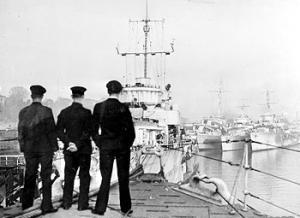HMS Ferret (1940 shore establishment)
 Three sailors view numerous destroyers of the escort group B7, which are moored alongside each other after returning home to Londonderry, Northern Ireland from a patrol in the north Atlantic. Identifiable vessels include HMS Versatile, HMIS Godavari, HMS Vanessa, HMS Vidette and HMS Rochester.
| |
| History | |
|---|---|
| Name | HMS Ferret |
| Commissioned | 9 December 1940 |
| Decommissioned | 21 June 1947 |
| Fate | Decommissioned, re-established as HMS Sea Eagle |
| General characteristics | |
| Class and type | Stone frigate |
HMS Ferret was a
History
With the outbreak of the Second World War and the start of the
Part of
American presence
The
Later developments
By 1942 Beech Hill Camp had been commissioned as HMS Ferret III, and the base had become an important centre for anti-submarine training.[2] British and other allied submarines were sometimes used to simulate real conditions. New technological developments were also worked on to improve anti-U-boat measures. One of the innovations developed here was the Squid Mortar.[4] The base became an important centre to train new crews, and refit ships transferred from America with the more effective British developments.[4] Some buildings were set aside to train crews in how to handle objects on deck, one building had a full cross-section of a destroyer's deck built inside it.[4]
Surrender of the U-boats
After the end of the war, large numbers of captured German
Postwar
Eventually over twenty thousand allied troops and sailors had passed through Ferret, and the base had been home to over two hundred ships of the Royal Navy,
Assessment
Professor J. W. Blake, in his 1956 book Northern Ireland and the Second World War summarised the importance of the work of HMS Ferret:
"Londonderry held the key to victory in the Atlantic. It became our most westerly base for the repair, the working up and refuelling of destroyers, corvettes and frigates. By that critical Spring (1943) when battle for the security of our Atlantic lifelines finally turned our way, Londonderry was the most important escort base in the north-western approaches."
References
- ^ a b c d "Ferret in N. Ireland". Archived from the original on 6 June 2008. Retrieved 27 May 2008.
- ^ a b c d e f g Ward, Shore establishments p. 75.
- ^ "History of 'Fort George'". Archived from the original on 15 June 2008. Retrieved 27 May 2008.
- ^ a b c d e f g h i A history of Ebrington Barracks Archived 6 June 2008 at the Wayback Machine
- ^ Imperial War Museum (2013). "THE ROYAL NAVY DURING THE SECOND WORLD WAR (A 29241; caption)". IWM Collections Search. Retrieved 12 March 2013.
- Warlow, Ben, Shore Establishments of the Royal Navy, Liskeard : Maritime, 2000. ISBN 978-0-907771-73-9
- Blake, J. W. Northern Ireland and the Second World War Blackstaff House, Belfast, 1956 ISBN 0-85640-678-3
- A history of Ebrington Barracks
- History of Ferret in N. Ireland
- The Geopolitics of Anglo-Irish Relations in the Twentieth Century, By Geoffrey R. Sloan (Google Books)
